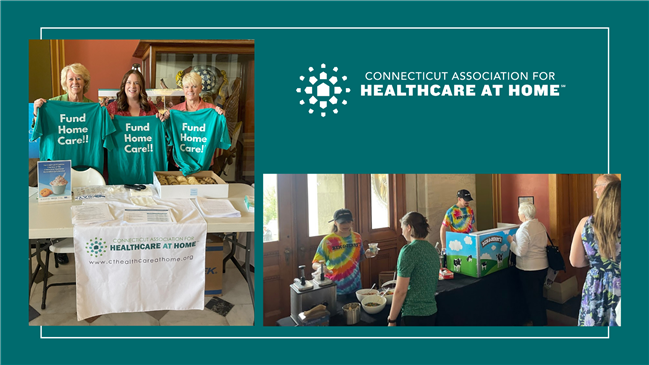 |
||||||||||||||||||||||||||||||||
| May 1, 2025 | ||||||||||||||||||||||||||||||||
Catch our CEO Tracy Wodatch on This Week in Connecticut with Dennis House as she discusses the critical future of Medicaid funding for home care. Tracy shares why investing in care at home matters for Connecticut families, patients, and the state’s healthcare system.
The Connecticut Association for Healthcare at Home will be participating in Senior Day at the Capitol (Hall of Flags, 1st floor) from 10 a.m. to 2 p.m. on Thursday May 8th. Additionally, the Connecticut Healthcare Collaborative Association (CHA, CAHCF, Leading Age and our association) will be hosting an Ice Cream and Cookie Social beginning at noon that day.
We need your support for this event. Come show the value of Care at Home…the preferred setting for Seniors to receive care! Source: CT Mirror, April 28, 2025
Connecticut Democrats have spent the last several months crisscrossing the state to warn residents about potentially devastating impacts of looming federal cuts to Medicaid.
Medicaid is the country’s biggest health plan, covering more than 70 million Americans. Known as HUSKY in Connecticut, Medicaid covers roughly 1 million people in the state, according to the Department of Social Services, which equals just about 25% of the population.
States depend heavily on the federal government to pay for the program. The state’s Office of Policy and Management projects Connecticut will spend a total of $11.6 billion on Medicaid this fiscal year. The federal government contributed roughly $6.9 billion, or 59%, of that funding.
Source: Alliance Daily, April 24, 2025
HIGHLIGHTS
On April 11, the Office of Management and Budget (OMB) issued a Deregulation Request for Information (RFI) seeking public input on federal regulations that may be overly burdensome or outdated. This is a key opportunity for the care at home industry to speak up and influence future policy.
As your national voice for home care, we are preparing comments—and we want to hear from you, our members.
Source: The Alliance, April 23, 2025
HIGHLIGHTS
The National Alliance for Care at Home is calling on all members and advocates to take immediate action to protect and strengthen access to home-based care. Congress is actively considering a number of policies that could dramatically impact patient access to essential services, the care at home workforce, and reimbursement for these vital services.
We are urging lawmakers to support legislation that has already been introduced and to reintroduce key bills from previous sessions that would protect and advance high-quality care in the home. Source: Alliance Daily, April 24, 2025
HIGHLIGHTS
The National Alliance for Care at Home is calling on all members and advocates to take immediate action to protect and strengthen access to home-based care. Congress is actively considering a number of policies that could dramatically impact patient access to essential services, the care at home workforce, and reimbursement for these vital services.
We are urging lawmakers to support legislation that has already been introduced and to reintroduce key bills from previous sessions that would protect and advance high-quality care in the home.
Source: AAHPM
While the majority of hospice agencies work hard to provide good care, stories about those that fail to live up to their ethical or legal obligations have appeared in prominent journalistic settings in recent years.
But if we dig deeper into quality, we see lots of questions about what quality hospice care really means. How can we define it, measure it, and make comparisons between providers that will be useful to consumers? And what can Academy members, individually and collectively, do about those hospices that diverge significantly from what we would consider minimum quality of patient care? What kinds of messages should hospices be delivering to their various publics about quality and about choosing the provider that will meet their particular needs?
Source: Becker's Hospital Review, April 17, 2025
While the post-pandemic nursing workforce is showing signs of stabilizing, high levels of burnout, stress and dissatisfaction continue to threaten long-term workforce stability, according to the National Council of State Boards of Nursing’s biennial 2024 National Workforce Study.
The report surveyed more than 800,000 nurses in the U.S. and is considered the largest, most comprehensive report on the state of the nursing workforce.
Source: CMS
|
||||||||||||||||||||||||||||||||
| Past Issues | Subscribe | cthealthcareathome.org | Advertise with Us | ||||||||||||||||||||||||||||||||







